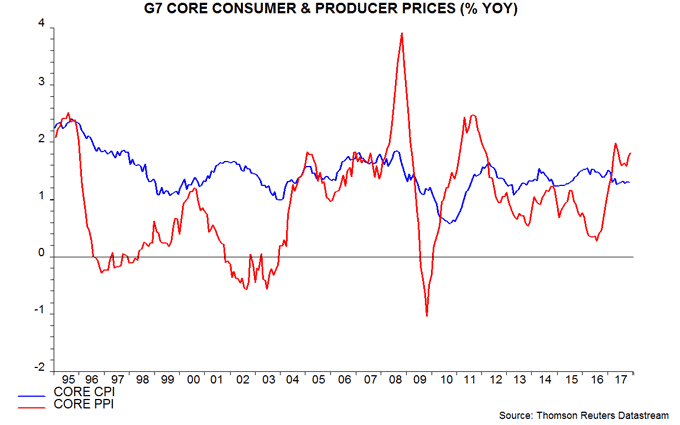Global growth near peak - are US tax cuts well-timed?
The favoured scenario for 2018 here is that global economic growth will moderate from around March while core consumer price inflation will rise through the year, causing major central banks – with the possible exception of the PBoC – to remain on a tightening tack. Three recent data developments lend support to this scenario.
First, global (i.e. G7 plus emerging E7) six-month real narrow money growth appears to have fallen further in November, based on monetary data covering two-thirds of aggregate tracked here – see first chart. The November drop reflected roughly equally a slowdown in nominal money expansion and a pick-up in six-month consumer price inflation, mainly due to stronger oil prices. Allowing for an average nine-month lead, the decline in real money growth from a most recent peak in June suggests that six-month industrial output expansion will moderate from March through August, at least.

Secondly, the slowdown signal from monetary trends is now receiving tentative confirmation from a shorter-term leading indicator derived from the OECD’s country leading indicator indices. Six-month growth of this indicator is estimated to have risen slightly further in November but one-month growth eased for a second month – second chart. The indicator typically leads by three to five months so the incipient softening is consistent with a loss of economic momentum in spring 2018.

Thirdly, G7 annual core producer price inflation* rose again in November and is well above its level in mid-2016; increases in the core PPI rate over 1999-2000, 2003-05, 2009-11 and 2013-14 were followed by a pick-up in core CPI inflation starting about a year later – third chart.

An obvious question is whether US tax cuts will mitigate or reverse the forecast global economic slowdown. A rise in spending intentions of US corporations and / or households would be expected to be signalled by a rebound in US real narrow money growth in early 2018. Such a rebound would suggest a revival of US and possibly global economic momentum in late 2018, i.e. the signal of a slowdown over the spring / summer would remain valid.
The view here is that the US / global stockbuilding cycle will peak in the first half of 2018 and act as an increasing drag on growth in late 2018 / 2019 – see previous post. On this basis, and assuming that the stimulative impact arrives in late 2018, tax cuts may prove to be well-timed – contrary to the consensus view. The bias here is to expect the effect to be insufficient to outweigh the stocks cycle downswing and drags from rising inflation and monetary policy tightening, implying that spring / summer economic weakening will extend into 2019; a firm judgement, however, will be deferred pending early 2018 monetary data.
*GDP-weighted average of US producer prices of finished goods excluding food and energy and closest available series in other G7 economies.

Reader Comments